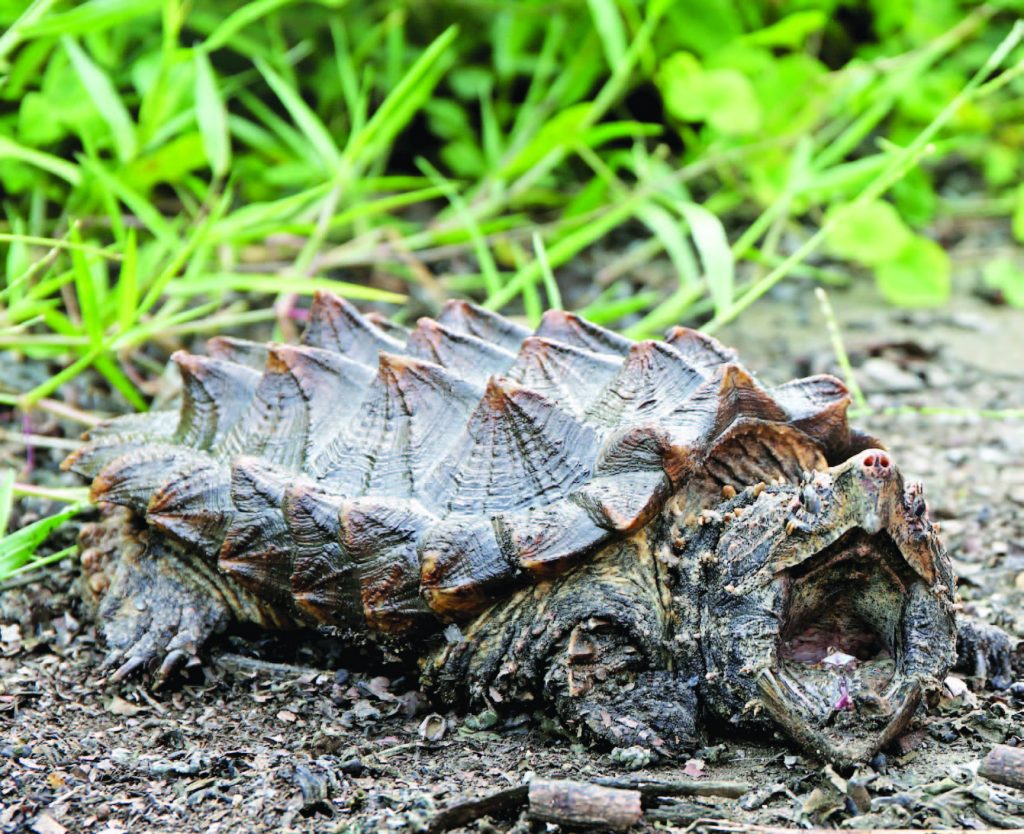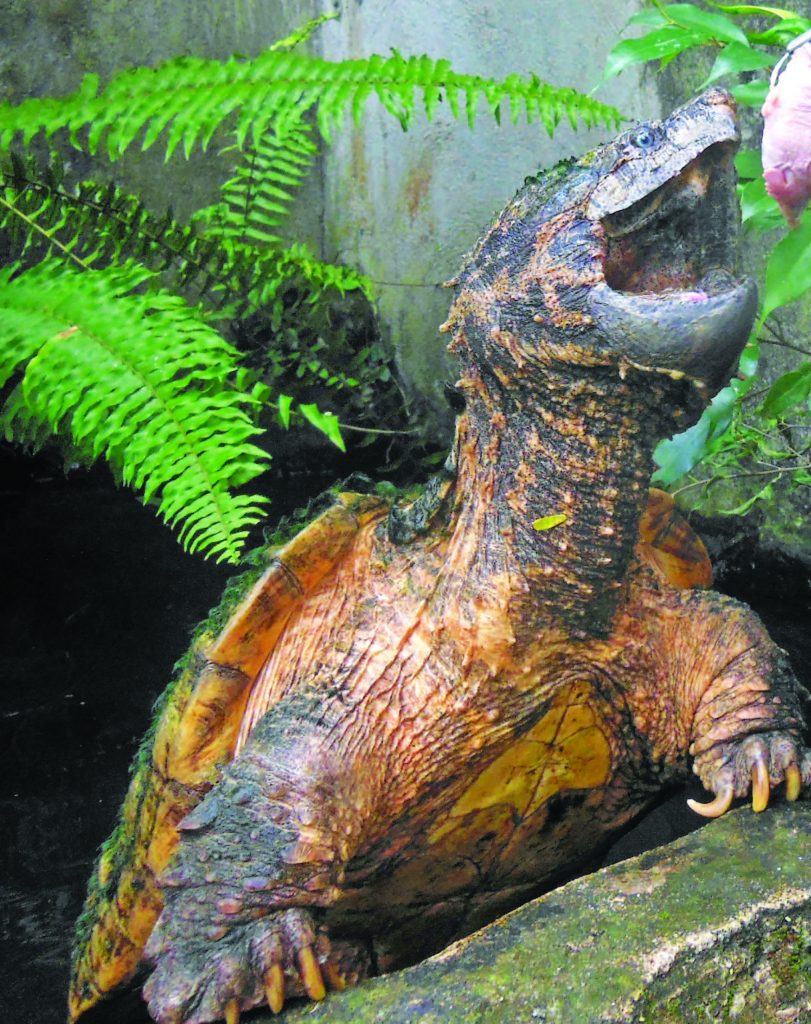I can’t remember the exact date, but that should be sometime mid-January, 2000. About two months previously, I acquired a blue-phase iguana and while it made an interesting pet with its hearty appetite and almost powdery blue color, I wanted a more responsive animal. Or should I say, I wanted a more aggressive animal.
At that time, I was keeping venomous snakes, which included a King cobra (Ophiophagus hannah), a Philippine cobra (Naja philippinensis), Malayan moccasins (Calloselasma rhodostoma), death adders (Acanthophis antarcticus), and arboreal vipers from the genera Trimeresurus and Tropidolaemus. I had honed my herpetocultural skills enough that I could work with often belligerent animals with little worry of getting bitten, so I wanted a little more excitement, so to speak.

The opportunity came January of that year when a friend asked me if he could trade his tiny alligator snapper for my iguana. He knew I was on the lookout for a more spirited reptile. Days later, he came over with a turtle with about a two-inch shell — the little beast was smaller than the diameter of my palm. I had a five-gallon tank I prepared in advance for the little chap’s arrival, with some feeder fishes inside, then allowed the turtle to settle in for a few days.
On the second day, I observed the turtle starting to stalk the fishes but would not seem to catch one, so I fed it with thawed freshwater shrimps, which it ate, albeit with some hesitation. A few days later, I noticed rocks covered with slime and it wasn’t until a few more days after that that I was finally able to determine what was going on: I saw the reptile swallow rocks to be used as gastroliths to aid digestion, in much the same way as crocodilians did.
Sizable snapper
The alligator snapping turtle (Macrochelys spp.) is the largest freshwater turtle in the entire North American continent, and is widely distributed in the southeastern United States. Apart from M. temminckii, two more species were described under the genus — M. apalachicolae and M. suwanniensis — and this implies that each of the turtle’s populations are actually smaller than what was previously considered when all were still regarded to belong to one species, M. temminckii.

Alligator snappers are capable of reaching shell lengths to about 70 centimeters and weights of about a hundred kilograms; size-wise, they are only rivalled by the Asiatic soft-shelled giants such as Chitra chitra, Rafetus swinhoei, and Pelochelys cantorii, the latter occurring in the Philippines but very rarely.
The life of a teenage turtle
Kaiju, as I had named her — her, because there was not much bulge on the cloacal vent — grew steadily and on the subsequent years was large enough to be fed larger food items. Rhinoceros beetle larvae (Oryctes rhinoceros), African land snails (Achatina fulica), and chicken heads were staple food items, as well as the occasional water lettuce or quiapo (Pistia stratiotes).
The bite force was strong enough to easily break snail shells and one afternoon, a group of Mormon missionaries passed by the house and asked to see the alligator snapper, obviously from a tip given by the neighbors. So, I fished Kaiju out and as I was maneuvering the turtle so the guests could get good photos, the indignant turtle snapped sideways and caught the base of my left thumb, which bled profusely. That was the first and last accident I ever got from the turtle.
When I moved to my present location I had her placed in a pond stocked with tilapia to keep mosquito larvae and algae at bay, although as would be expected, Kaiju sees the pest control as her dinner source. Nevertheless, two tilapias born on the pond by one of the previous residents have managed to steer clear out of those murderous jaws.

Now on her 18th year, Kaiju has a 14-inch carapace and a length of roughly 25 inches from snout to tail in a resting position. The last time I lifted her out of the water was about two years ago, and I reckon she would be around 10 kilos as of this writing.
She has become an attraction to visitors, particularly to the first-timers who get kicks seeing her being fed with chicken heads — and an even greater thrill when they get asked to feed the leviathan themselves, using either a pair of 12-inch tongs or forceps. She eats water lettuce and Hydrilla, too, but where’s the fun in feeding a massive beast such plant matter from a pair of tongs?
Offense is the best defense
The shell of Macrochelys is distinctly three-ridged with serrated posterior margins, while the plastron is very small and cross-shaped. Turtles in the family Chelydridae, which also include the common snappers (Chelydra serpentina), are incapable of retracting their heads and tails into the shell, which probably also explains their often aggressive nature: With their shells unable to provide protection to the extremities, the turtles have resorted to defensiveness to secure themselves from potential predators.

Not surprisingly, many other turtles with shells that are useless as a protective measure to the head are also defensive, such as the Asian big-headed turtles (Platysternon spp.) and the trionychids, or the softshell turtles. Due to their often cryptic lifestyle, the shell is usually colonized by algae, which serves to provide camouflage. Additionally, the skin has short, fleshy filaments and these are also present on the eyes, thereby effecting better concealment from potential prey.
Thinking turtle
Like many other turtles, she had tremendous feeding response, and would approach me as I changed the water in fish tanks or when I watered the plants. Amusingly, she would sometimes wiggle her wormy tongue whenever she faced me.
But she knew when it was feeding time and when it was not: If I was around and had not tossed anything into her pond within seconds, she knew she wasn’t going to get anything. That made it easy for me to change the water or clean her pond, and when I did, she just stayed in one corner until the water was practically gone, after which she would start wandering around her enclosure and I needed to watch my feet.
Leaving her be
When Kaiju was younger, I would scrub her shell clear of algae. It caused her to be spastic and she become overly aggressive, so I now allow a lush layer of algae layer on her shell. Probably because she is now a teenage turtle curious of the world around her, she often comes out of her pond to explore her surroundings. A loud thud is all I need to know that she is out of her pond and walking around again, out to bulldoze the potted plants which I have moved out of her reach.
Twice, I could not open the door going to her pond, only to see this big lump of armored brute blocking the door. One time, I left the door open and she entered the house silently, until I noticed one of the cats arching his back in distress. So, I tapped Kaiju’s back with a snake hook and showed the door, and she hissed and lumbered back to her pond, wondering why she wasn’t allowed to watch television.
But that was when I lived alone. Nowadays, the door leading to her pond is always closed; she has no choice but to watch the birds and the dragonflies hovering above, instead of the TV.
Demeanor-wise, she can get very defensive when picked up, and even mere taps on her shell cause her to arch her back and make a few attempts at snapping back. One American friend who paid a visit and picked her up for the first time commented that I probably wasn’t handling her as often as I should, which could explain the ornery temperament. But I was not a hands-on person, and somehow I could not imagine petting this primordial-looking chelonian even when she was little. So yes, I had no problem with her temperament. She only wanted to be left alone.
Curiosity won’t kill this turtle
I must admit that on at least two occasions while reaching out for plants above the pond, I jumped back upon seeing that she was only mere inches from my feet, very still but with a somewhat hilarious, quizzical look of wonderment as to why I panicked in the first place. She could be that stealthy, but she wouldn’t snap.
Whenever she sneaked up on me, I knew that it was entirely out of inquisitiveness. It might only be that this primal instinct on my part had programmed me to keep a healthy respect for this animal. And that, I knew, was the key to maintaining such large and potentially confrontational beasts: a healthy dose of respect.
As long as nothing untoward happens to her, Kaiju will surely outlive me. I already have prepared a much larger pond for her when the current one proves to be too limited for her. And while people pass objects as heirloom to the next generation, by the way things are going, I am going to pass her on to my son and perhaps future grandkids — a chelonian dinosaur for the ages.
Food in a snap
Macrochelys are omnivorous and will feed on aquatic plants and practically any animal they can overpower.
A curious feature of alligator snappers is the worm-like tongue which they move to inveigle prey, particularly fishes and crustaceans. The muddy coloration of the mouth provides a good backdrop for the pinkish lure.
Incidentally, this is the only known turtle species that uses a ruse to capture prey.
This appeared in Animal Scene magazine’s April 2019 issue.





